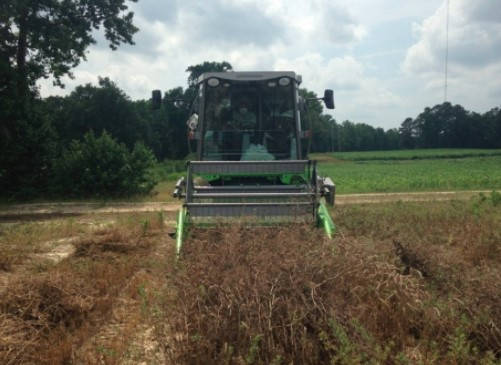By Rachel Atwell Vann
Introduction
North Carolina ranks number two in U.S. poultry, egg, turkey, and hog production; but ranks eighteenth in U.S. grain production (USDA, 2016). This results in, on average, a 200-million-bushel-per-year feed grain deficit (Shore, 2015), and necessitates many livestock feed imports. Soybean is imported in large quantities for use as a protein source in livestock feed rations; this is a significant cost for livestock producers in the state.
Winter pea grain could be used to supplement soybean in total mixed rations fed to livestock because of its high protein concentration levels. Concentrations of protein and starch in pea grain range from 15 to 35% and 35 to 50%, respectively. Peas can be fed directly to livestock, unlike soybeans which require heat processing prior to animal consumption (Miller et al., 2005). Additionally peas have low allergenicity and contain some amino acids that are deficient in small grains. Pea can be grown over the winter in North Carolina, and therefore would not be competing with soybean acreage during the summer.
Winter pea can be grown in mixture with wheat and the two species can be harvested simultaneously for grain. Growth in mixture with small grains can help reduce pea disease incidence, reduce lodging, and can increase total grain yields.
Minimal effort has been devoted to investigating the grain potential of winter pea in North Carolina and a regional screen of available winter pea cultivars for grain production in North Carolina has not occurred.
Objective
The objective of this experiment was to identify winter pea cultivars that can be grown in monoculture and in mixture with wheat for grain production in North Carolina.
Methods
Experimental sites: Studies were conducted from 2014 to 2016 at the Central Crops Research Station in Clayton, NC, the Caswell Research Farm in Kinston, NC, and the Piedmont Research Station in Salisbury, NC. The Clayton sites were a loamy sand, the Kinston sites were a sandy loam, and the Salisbury sites were a clay loam. Phosphorous and potassium were applied as necessary based on NDCA recommendations. Nitrogen fertility was not applied at any sites. Preemergence herbicides were used for weed control at several study sites; no postemergence herbicides were used and the mixture was relatively competitive with weeds in the spring.
Winter pea cultivars and genotypes: Nineteen winter pea genotypes were screened for grain potential. This included twelve released cultivars: CAH-11, Chelan, Common, Fenn, Glacier, Granger, Lynx, Melrose, Racer, Romack, Specter, and Windham, and six advanced USDA-ARS breeding lines: PS07300136W, PS09300095W, PS10300120W, PS10300121W, PS06300028W, and PS0017018W. We also screened the current winter pea cultivar readily available in North Carolina (Nature’s Choice (NC)). Winter pea seed size varies widely by cultivar, therefore we seeded the winter peas using a plant population of 180,000 seeds/acre in monoculture (approximately 90 lbs/acre)
Pea emergence at the Piedmont Research Station in Salisbury, NC
Variation among pea genotypes.
Winter pea and wheat mixture: Each winter pea genotype was tested not only in monoculture but also in mixture with three winter wheat cultivars of differing maturities. These included USG 3120 (early maturing), FeatherStone VA 258 (medium maturing), and NC Yadkin (late maturing). Winter pea was seeded in mixture at 120,000 seeds/acre (approximately 60 lbs/acre) and the wheat was seeded at 375,000 seeds/acre (approximately 30 lbs/acre).
Pea and wheat grown in mixture.
Planting and harvesting: The research plots were planted from late September through mid-October using a small-plot grain drill. The plots were harvested in June using a small-plot combine. Both the monoculture pea plots and the mixture plots were harvested with the soybean bottom sieve in the combine. Generally, the wheat cultivars were mature prior to most pea genotypes. This allowed for a simultaneous grain harvest as soon as the peas reached physiological maturity. Some of these pea genotypes are indeterminate (the pods will not all mature at the same time); identifying the correct time to harvest was the most challenging part of harvesting the peas. Pea lodging following late spring storm events also slowed down harvest, however it was possible to pick the lodged peas up off the ground with the combine for grain harvest. At one site, we did see reduced pea lodging when the pea was planted in mixture with wheat compared to growth in monoculture.

Harvesting winter pea and wheat simultaneously using the soybean sieve in our combine.
Pea lodging following a spring storm.
Collected data: Pea cold tolerance, pea disease incidence, pea maturity, and pea and wheat grain yield.
Results
Pea cold injury: Most pea genotypes survived the North Carolina winter with minimal cold injury. The cultivar Racer was the earliest flowering pea genotype and experienced the greatest cold injury across sites; we would not expect this cultivar to consistently survive the North Carolina winter. There was also minor cold injury observed occasionally with the cultivar Romack, but the plants were able to outgrow this injury and grain yield was not affected. Growth in mixture with wheat did not prevent Racer or Romack from experiencing cold injury.
Click here to see more...